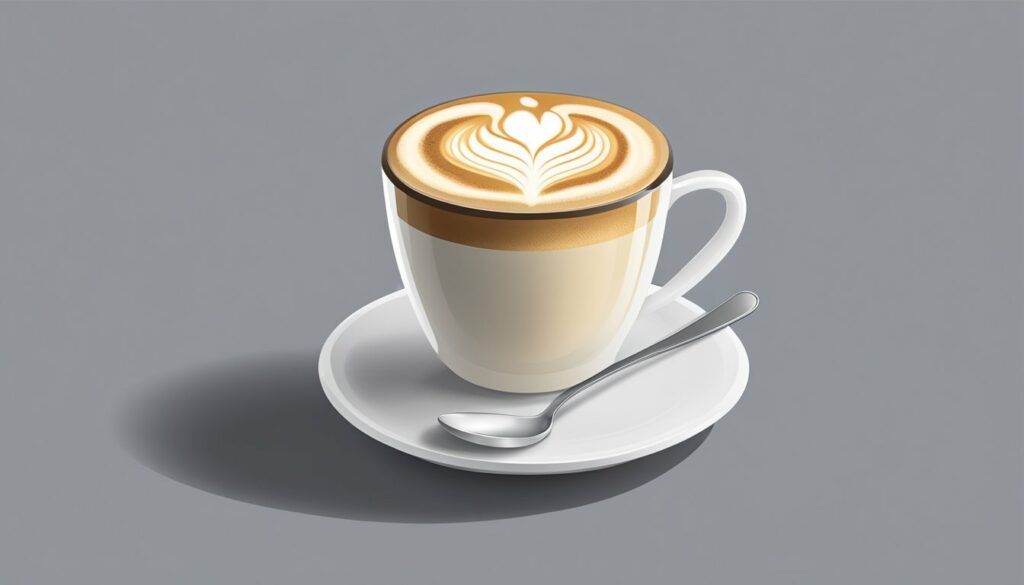
Cappuccino – a word that evokes images of cozy coffee shops and a delightful blend of bold flavors and creamy texture. But do you know what really sets a cappuccino apart from other coffee beverages?
Key Takeaways
- A cappuccino is a well-loved coffee drink made from espresso, steamed milk, and milk foam.
- The drink offers a perfect balance between the intense espresso flavor and the smoothness of milk.
- Serving size and milk-to-espresso ratio play a significant role in creating a memorable cappuccino.
A cappuccino is a classic Italian coffee that features a harmonious combination of espresso, steamed milk, and milk foam. Served in smaller cups than lattes, cappuccinos boast an enticing balance of strong espresso flavor and velvety milk, resulting in a satisfying coffee experience.
What is a Cappuccino?
As a coffee enthusiast, you might have come across the lovely cappuccino, a popular Italian coffee drink. But what exactly is a cappuccino and what makes it so special? Let’s dive into the fascinating world of this espresso-based beverage.
A cappuccino is a delightful blend of espresso, hot milk, and milk foam that comes together to create a rich, smooth, and creamy taste. To make a cappuccino, your friendly barista starts by brewing a shot of espresso. This concentrated, bold and flavorful coffee serves as the foundation of your drink.
Next, they turn their attention to the hot milk. Steamed milk makes up an important part of the cappuccino, contributing to its velvety texture. Baristas carefully steam the milk so that it reaches the perfect temperature and consistency, ensuring your cappuccino is both delicious and enjoyable.
The final component is the milk foam. This airy, frothy layer is created by skillfully frothing milk until it takes on a light and airy consistency. The milk foam not only adds visual appeal to the cappuccino but also delivers a delightful mouthfeel that complements the bold espresso and smooth, hot milk.
When it comes to proportions, a traditional cappuccino follows a 1:1:1 ratio of espresso, steamed milk, and milk foam. By maintaining this balance, the unique flavors of the espresso can shine through, while the hot milk and foamed milk round out the taste and create the signature cappuccino experience.
A cappuccino is an exquisite Italian coffee drink that combines the bold flavor of espresso with the smoothness of hot milk and the lightness of milk foam. The result is a delightful and well-balanced beverage that can brighten your day and satisfy your taste buds. Enjoy!
Creating the Perfect Cappuccino
Ingredients Needed
To create the perfect cappuccino, you’ll need the following ingredients:
- Coffee: Ideally, use freshly ground espresso beans for the best flavor.
- Milk: Whole or 2% milk provides a better froth. You can also use non-dairy milk alternatives, such as almond or soy milk.
- Water: Fresh, filtered water is essential for brewing quality coffee.
Optional ingredients include:
- Sugar: Adjust to your taste preference.
- Cocoa powder or cinnamon: For garnishing purposes.
Preparing a Cappuccino
To prepare a cappuccino, follow these steps:
- Make the espresso: Using an espresso machine, pull a single or double shot of espresso.
- Steam the milk: Pour cold milk into a frothing pitcher, and use the steam wand of your espresso machine to heat & froth the milk. Aim for a microfoam texture, which is dense and creamy.
- Pour the steamed milk: Hold back the froth using a spoon, and pour the steamed milk into your espresso shot to fill about 2/3 of the cup.
- Add the milk froth: Gently spoon the froth over the steamed milk until your cup is full. Aim for a 1:1:1 ratio of espresso, steamed milk, and milk foam.
Variations and Adjustments
Feel free to experiment with these variations for your cappuccino:
- Dry Cappuccino: Increase the milk foam and reduce the steamed milk for a stronger, less creamy coffee.
- Wet Cappuccino: Use more steamed milk than foam for a creamier, smoother texture.
- Iced Cappuccino: Create an iced version by pouring your espresso and milk mixture over ice.
- Matcha Cappuccino: Substitute matcha green tea for espresso to create a caffeinated alternative with a unique flavor.
Remember, practice makes perfect! Adjust the coffee, milk, and optional ingredients to your personal taste to create your ideal cappuccino experience.
Nutritional Profile of a Cappuccino

When you enjoy a cappuccino, it’s good to know about its nutritional profile. In a standard 8-ounce cappuccino, you can expect to find approximately:
- Calories: 74-100 calories
- Fat: 3-4 grams, mostly saturated fat
- Protein: Roughly 3 grams
- Sugars: 5-6 grams, depending on the type of milk used
- Cholesterol: About 12 mg
Unfortunately, a cappuccino doesn’t provide a significant amount of vitamins and minerals like Vitamin C, calcium, iron, and potassium. However, the drink still has some benefits, such as providing a small amount of calcium from the milk.
Here’s a concise breakdown of the nutritional profile of an 8-ounce cappuccino:
| Nutrient | Amount |
|---|---|
| Calories | 74-100 |
| Fat | 3-4 g |
| Protein | ~3 g |
| Sugars | 5-6 g |
| Cholesterol | 12 mg |
To make your cappuccino a healthier choice, you can opt for skim milk, which reduces the calories and fat content. You should also consider avoiding added syrups, sauces, and whipped cream, as these additions can significantly increase the calorie and sugar content.
On the other hand, remember that this delicious beverage does contain caffeine, so keep your daily intake in moderation. Enjoy your cappuccino and make mindful choices to fit your dietary needs!
Exploring the History of Cappuccino
Cappuccino has a fascinating history that takes you back to its origins in Italy and its influence in America. It is said that the name “cappuccino” comes from the Italian word “cappuccio,” meaning hood or cap, inspired by the frothy milk foam that sits on top of the espresso like a cap.
In the beginning, cappuccino was influenced by the Viennese coffee houses in the 1700s, where it was known as the ‘Kapuziner.’ Early descriptions of the Kapuziner mentioned it as “coffee with cream and sugar,” while later descriptions from 1850 added “spices” to the recipe. The Capuchin Friars, an order of monks recognized for their hooded attire, are also commonly associated with the history of cappuccino.
When you think of Italian cappuccino, it is important to mention the invention of the modern espresso machine by Luigi Bezzera in the early 20th century. The creation of this machine shed a new light on cappuccino, making it possible to brew a stronger, more concentrated coffee. Over time, the art of steaming and frothing milk to perfection enhanced the cappuccino, giving it its iconic appearance and taste.
As the popularity of cappuccino spread from Italy, it found its way to American shores in the 20th century. In the United States, cappuccino has become a popular fixture in many coffee shops, with some variations involving the use of cream instead of milk and flavoring with cinnamon.
Nowadays, the classic Italian cappuccino is an espresso-based drink made of one-third espresso, one-third steamed milk, and one-third frothed milk. When you enjoy a cappuccino at a café, take a moment to appreciate the rich history and flavors that have made this drink a beloved favorite across continents, countries, and cultures.
We want to remind our readers that the articles or content found on afullmug.com do not constitute nor replace professional health or dietary advice. The information provided on our website is purely educational and informational, and should not be used as a substitute for advice from a licensed dietician, medical practitioner, or nutritionist.


